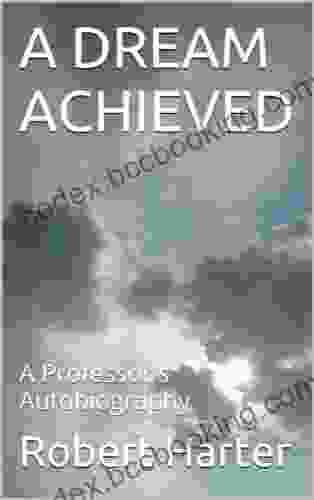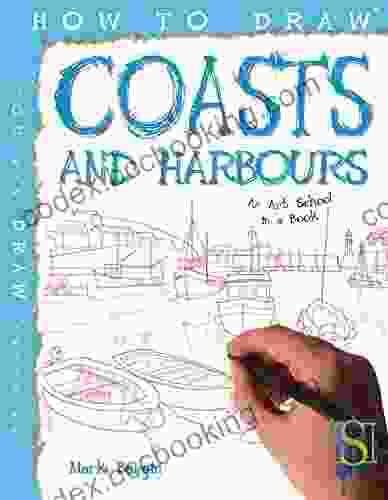How To Draw Coasts And Harbours: An Artist's Guide to Capturing the Beauty of Nature

: Unlocking the Art of Coastal and Harbour Depictions
Prepare yourself for an exhilarating adventure as we venture into the realm of drawing coasts and harbours. These captivating natural wonders, with their towering cliffs, crashing waves, and serene shores, present a mesmerizing canvas for artistic expression. In this comprehensive guide, we will embark on a journey to unlock the secrets of capturing the essence of these awe-inspiring landscapes.
4.4 out of 5
| Language | : | English |
| File size | : | 15011 KB |
| Screen Reader | : | Supported |
| Print length | : | 32 pages |
Whether you are a novice artist yearning to spread your wings or a seasoned professional seeking to refine your skills, this guide will serve as your trusted companion. We will delve into the intricacies of coastline drawing, exploring techniques that will enable you to portray the rugged grandeur of sea cliffs, the gentle curves of sandy beaches, and the mesmerizing play of light and shadow upon the water's surface.
Our exploration will not be confined solely to the coastline; we will venture into the heart of harbours, where human ingenuity meets the raw power of nature. You will learn to depict the intricate details of boats and ships, the bustling activity of docks and piers, and the interplay of light and shade that transforms these maritime havens into a symphony of colours and textures.
Join us on this artistic odyssey, and let us together unravel the secrets of drawing coasts and harbours. With each stroke of your pencil or brush, you will not only create stunning works of art but also embark on a journey of self-discovery, forging a deeper connection with the beauty that surrounds us.
Chapter 1: Understanding the Elements of Coastal and Harbour Landscapes
Before embarking on our drawing adventure, it is essential to familiarize ourselves with the fundamental elements that define coastal and harbour landscapes. These elements serve as the building blocks upon which we will construct our artistic interpretations.
1.1 Coastlines: Where Land Meets Sea
Coastlines, where the relentless waves of the ocean meet the unyielding embrace of the land, present a captivating tapestry of forms. They can be broadly categorized into three main types:
- Rocky Coasts: Characterized by towering cliffs, jagged rocks, and pounding surf, rocky coasts exude a sense of rugged beauty.
- Sandy Coasts: Gently sloping beaches, golden sands, and rolling dunes define sandy coasts, inviting us to bask in their serene embrace.
- Muddy Coasts: Often found in sheltered areas, muddy coasts are marked by soft, sediment-rich shores and the ebb and flow of tidal mudflats.
1.2 Harbours: Shelters of Tranquility and Activity
Harbours, sheltered havens for boats and ships, offer a unique blend of natural beauty and human industry. They can be classified into two primary types:
- Natural Harbours: Created by the protective embrace of cliffs, headlands, or islands, natural harbours provide shelter from the open sea.
- Man-Made Harbours: Constructed through engineering ingenuity, man-made harbours feature breakwaters, jetties, and piers, extending their protective embrace into the depths of the ocean.
1.3 Boats and Ships: Vessels of Human Endeavour
The presence of boats and ships in coastal and harbour scenes adds a touch of human activity and purpose to the natural landscape. These vessels come in a myriad of shapes and sizes, from sleek sailboats to towering cargo ships, each with its own unique character and story to tell.
Chapter 2: Essential Techniques for Depicting Coastlines
With a firm grasp of the elements that define coastal landscapes, we can now embark on the practical aspects of drawing them. In this chapter, we will explore fundamental techniques that will enable you to capture the essence of these rugged and beautiful environments.
2.1 Capturing the Ruggedness of Rocky Coasts
Rocky coasts, with their dramatic cliffs and crashing waves, pose a unique challenge for artists. To effectively depict their rugged beauty, consider these tips:
- Use bold lines and strong contrasts: Strong, confident lines will convey the solidity and scale of rocky formations.
- Pay attention to texture and detail: Observe the intricate textures of rocks, from smooth surfaces to jagged edges.
- Depict the movement of waves: Capture the energy and rhythm of crashing waves through dynamic lines and expressive brushstrokes.
2.2 Rendering the Serenity of Sandy Coasts
Sandy coasts, with their gentle curves and tranquil shores, offer a more subdued but equally captivating subject matter. To capture their serene beauty, try these techniques:
- Use soft, flowing lines: Gentle, meandering lines will evoke the sense of movement and fluidity associated with sandy beaches.
- Pay attention to the play of light and shadow: Observe how light and shadow interact with the contours of dunes and the rippling surface of the water.
- Depict the details of vegetation: Sandy coasts often feature a variety of plant life, adding texture and colour to the landscape.
2.3 Capturing the Subtleties of Muddy Coasts
Muddy coasts, with their soft shores and tidal mudflats, present a more subtle subject matter. To effectively portray their unique beauty, consider these tips:
- Use muted colours and subdued tones: Muddy coasts lack the vibrant hues of other coastal environments, so opt for a more restrained colour palette.
- Pay attention to textures and patterns: Observe the intricate patterns created by tidal flows and the textures of mud and sediment.
- Depict the interplay of water and land: Capture the dynamic relationship between the water and the soft, yielding shores.
Chapter 3: The Art of Drawing Harbours
Having explored the intricacies of coastline drawing, we now turn our attention to the captivating world of harbours. These bustling hubs of maritime activity present a unique set of challenges and opportunities for artists.
3.1 Depicting the Protective Embrace of Natural Harbours
Natural harbours, sheltered by cliffs, headlands, or islands, offer a sense of protection and tranquillity. To capture their beauty, try these techniques:
- Emphasize the surrounding landforms: The cliffs, headlands, or islands that form the natural harbour should be depicted as prominent features.
- Capture the calmness of the water: Natural harbours are often characterized by calm waters, so use smooth, flowing lines to convey this sense of stillness.
- Depict the human presence: While natural harbours offer shelter, they are also often home to human settlements and activities.
3.2 Drawing Man-Made Harbours: A Symphony of Engineering and Nature
Man-made harbours, with their breakwaters, jetties, and piers, showcase the ingenuity of human engineering. To effectively depict them, follow these tips:
- Capture the geometric shapes and structures: Man-made harbours are characterized by their geometric forms, so pay attention to angles, lines, and curves.
4.4 out of 5
| Language | : | English |
| File size | : | 15011 KB |
| Screen Reader | : | Supported |
| Print length | : | 32 pages |
Do you want to contribute by writing guest posts on this blog?
Please contact us and send us a resume of previous articles that you have written.
 Book
Book Novel
Novel Page
Page Chapter
Chapter Text
Text Story
Story Genre
Genre Reader
Reader Library
Library Paperback
Paperback E-book
E-book Magazine
Magazine Newspaper
Newspaper Paragraph
Paragraph Sentence
Sentence Bookmark
Bookmark Shelf
Shelf Glossary
Glossary Bibliography
Bibliography Foreword
Foreword Preface
Preface Synopsis
Synopsis Annotation
Annotation Footnote
Footnote Manuscript
Manuscript Scroll
Scroll Codex
Codex Tome
Tome Bestseller
Bestseller Classics
Classics Library card
Library card Narrative
Narrative Biography
Biography Autobiography
Autobiography Memoir
Memoir Reference
Reference Encyclopedia
Encyclopedia Will Chesney
Will Chesney Emma Vanstone
Emma Vanstone Ulysses S Grant
Ulysses S Grant Emily Jenkins
Emily Jenkins Hassan Osman
Hassan Osman Emma Gift
Emma Gift Jessica Augustsson
Jessica Augustsson Emmanuel Jal
Emmanuel Jal Emil Ferris
Emil Ferris Michael D Antonio
Michael D Antonio Scoop Malinowski
Scoop Malinowski Maria Lichty
Maria Lichty Emily Smith
Emily Smith Jill Ker Conway
Jill Ker Conway Emma Child
Emma Child Emma Warren
Emma Warren Stephan Lee
Stephan Lee Jane Gleeson White
Jane Gleeson White Ellen Hopkins
Ellen Hopkins Rosalind Rosenberg
Rosalind Rosenberg
Light bulbAdvertise smarter! Our strategic ad space ensures maximum exposure. Reserve your spot today!

 Everett BellUnveiling the Enigmatic Ryomen Sukuna: A Comprehensive Exploration of Jujutsu...
Everett BellUnveiling the Enigmatic Ryomen Sukuna: A Comprehensive Exploration of Jujutsu...
 E.E. CummingsUnveiling the Hidden Depths: A Psychological Exploration of Art's Captivating...
E.E. CummingsUnveiling the Hidden Depths: A Psychological Exploration of Art's Captivating... Reed MitchellFollow ·7.4k
Reed MitchellFollow ·7.4k Douglas PowellFollow ·2.2k
Douglas PowellFollow ·2.2k Timothy WardFollow ·17.4k
Timothy WardFollow ·17.4k Jake PowellFollow ·19.7k
Jake PowellFollow ·19.7k Trevor BellFollow ·8.1k
Trevor BellFollow ·8.1k Ivan TurnerFollow ·14.1k
Ivan TurnerFollow ·14.1k Brady MitchellFollow ·9.2k
Brady MitchellFollow ·9.2k Robbie CarterFollow ·6.9k
Robbie CarterFollow ·6.9k

 Isaias Blair
Isaias BlairEscape to Sunrise Cottage: A Captivating Read You Won't...
Are you ready for a...

 Bradley Dixon
Bradley DixonWhen Baby Is Born, So Is Mother: A Comprehensive Guide to...
Giving birth is a...

 Mario Simmons
Mario SimmonsPhotographic Journal of Cruise Around South America: A...
Embark on an Extraordinary Expedition ...

 Langston Hughes
Langston HughesDream Achieved: Unlocking the Power Within to Make Your...
In the tapestry...
4.4 out of 5
| Language | : | English |
| File size | : | 15011 KB |
| Screen Reader | : | Supported |
| Print length | : | 32 pages |











